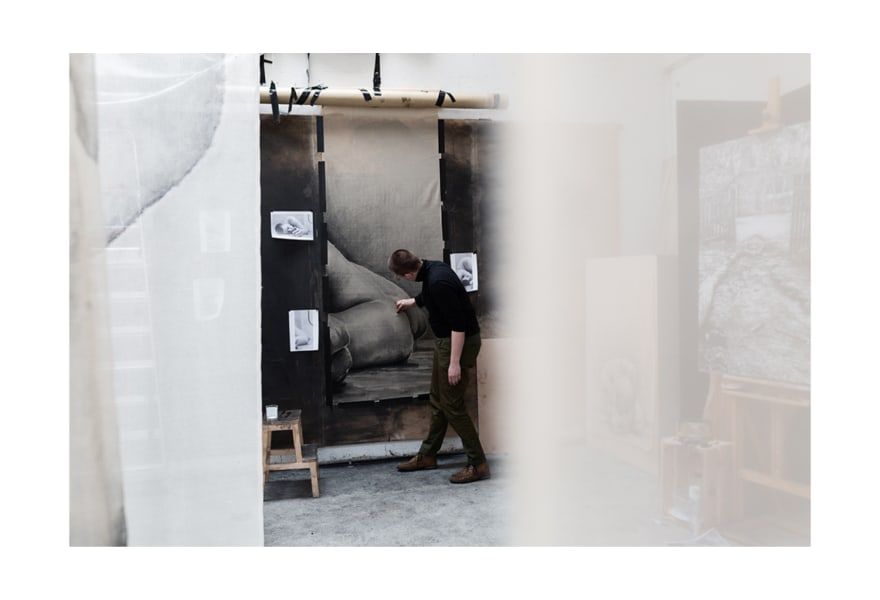27 january 2025, Wouter van den Eijkel
The studio of... Lise Lou Sore
Lise Lou Sore creates self-portraits. They do not depict a face in serene calm, as is customary, but rather intense, raw emotions. Sore invites you to share in deeply vulnerable experiences. The scale of the work does the rest. Sore creates these drawings on meters-high cheesecloth, often curled up with hands over their ears or eyes tightly closed, with almost tangible emotion.
Sore creates monumental self-portraits on cheesecloth, a medium that aligns well with the fleeting nature of these emotions. The soft, fluid appearance also contrasts beautifully with the intensity of the drawings.
Thematically, much of Sore's work can be traced back to early childhood, which was spent in the West African country of Niger. Sore describes the transition to the Netherlands as a shock. The emotions of loss and adjustment are recurring themes in the work. “In Africa, there is a greater focus on community and caring for one another, whereas in the West, the emphasis is on individual achievement. That contrast has always fascinated me and forms the basis of my analysis of emotions: What do they mean and how do I find my place within them?”
Where is your studio and how would you describe it?
My studio is located in an old paper warehouse in Breda, an unremarkable building with three distinctive arches in the middle of a residential area. Incidentally, this neighbourhood was built around the warehouse later on. In the 1990s, a group of passionate artists bought the building and converted it into eight studios. It’s a unique place, spacious and inspiring.
My own studio is around eight metres long and six metres wide, and approximately three to three-and-a-half metres high. I’ve installed a drawing wall where I can secure my canvases so they don’t shift while I work on them. My studio is truly my world, a place where I feel free and can draw and experiment for hours without distraction.
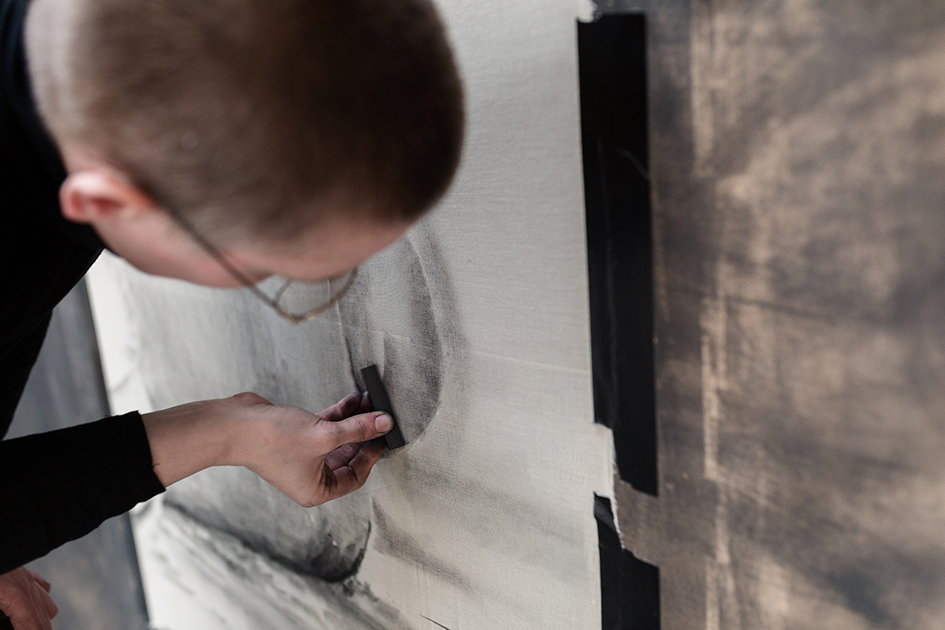
Lise Sore in the studio, 2021 © Charlotte Visser
What is a typical workday in your studio? Do you have routines? Do you listen to music or prefer silence? Do you welcome visitors or like to keep the door closed?
While my workweek certainly follows a certain rhythm, the work in my studio is far from routine. I’m there at least three days a week—sometimes just to have a cup of coffee, other times to immerse myself fully in my drawings. I always do the actual drawing in the studio, but the preparation work, such as gathering ideas or finding inspiration, happens everywhere and anywhere. During intensive work periods, I practically live in the studio day and night, while there are also weeks when I come here only to relax.
When I draw, I enjoy listening to music, often repetitive, as those recurring sounds help me concentrate. Sometimes, I watch series with recurring background sounds or listen to podcasts, as long as they’re not too distracting. When I’m not drawing, I like to watch documentaries as a source of inspiration. Generally, I prefer to keep my door closed, but I occasionally welcome guests or have a coffee with my neighbours. The fact that multiple artists share the same building is motivating.
Some artists describe their studio as a sanctuary, while others see it as a functional space. What about you?
My studio is absolutely a special place to me, almost like a second home. Sometimes, it even feels as though I live there. It’s an intimate place where not just anything happens; I deliberately keep it separate from other parts of my life. Yet, it also has a clear function: this is where I work, which can sometimes involve chaos. My studio is covered in a thick layer of charcoal dust, work hangs and lies everywhere and little space is left unused. That chaos can be very inspiring, but there are also times when I clean and tidy everything to prepare for visitors. So, it’s both a sanctuary and a functional workspace.

Lise Sore in the studio, 2021 © Charlotte Visser
In a previous interview, you mentioned spending your early years in Africa and how that influences your work. Can you elaborate?
I spent the first few years of my life in Niger, West Africa. It’s hard to describe exactly what that time meant to me, but moving to the Netherlands was a huge shock. From a freestanding house in a warm environment with sandy landscapes, surrounded by playing children, we moved into a small apartment with just a tiny balcony. As a child, I spent a lot of time on that balcony, even in winter, because I missed the freedom of being outdoors.
Those emotions—of loss and adjustment—are recurring themes in my work. In Africa, the focus is much more on community and caring for one another, while here in the West, the emphasis is on individual achievement. That contrast has always fascinated me and forms the basis for my analysis of emotions: What do they mean and how do I find my place within them?
On a more personal note, you’ve shaved your head for your self-portraits. Why?
In May 2018, I decided to shave my head. I was already creating self-portraits when I noticed that drawing my hair was time-consuming and distracted me from the expression on my face and body. By shaving my head, I give myself more freedom in my gender expression and enhance the focus on emotion in my work. It also gives me more comfort in everyday life. My self-portraits aren’t just about me as an individual, but about universal human emotions. ‘Neutralising’ myself amplifies that universal feeling.
You create both small and huge self-portraits, often capturing highly intimate, emotional moments. How do you do that, considering that nothing is as fleeting as an emotion? Does someone close to you have a camera ready?
To me, it’s essential that the emotions in my work are genuine. They can’t be staged. Since I was a teenager, I’ve been using a camera to photograph myself in moments of intense emotion. This process gives me something to hold on to while experiencing those emotions; capturing them feels like a way to gain control over what I’m going through at that moment. I often take pictures in the shower, a place where I find calm. Sometimes, a loved one helps me capture emotions like anger, which I find difficult to photograph myself. All these images form a database that serves as the basis for my drawings. The drawing process then becomes a prolonged, almost meditative study in which I literally enlarge, re-experience and understand every detail of the skin and emotion.
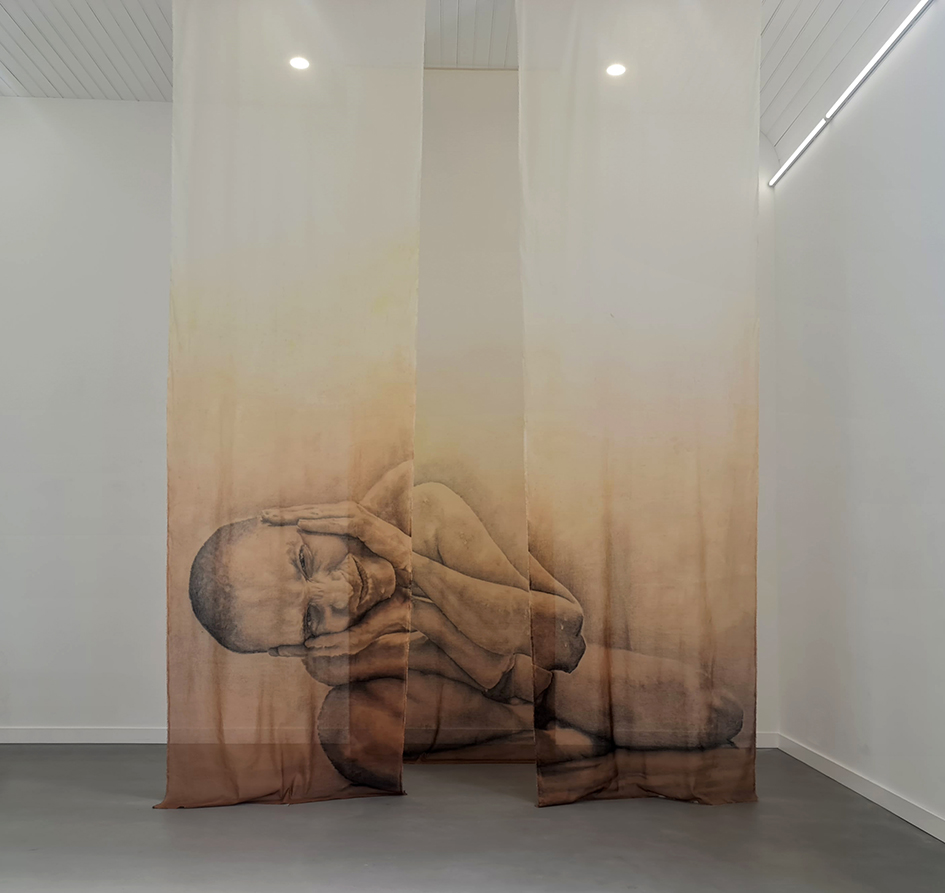
Lise Sore, Self-portrait, 2023. Mixed chalk, acrylic and ink on unbleached cotton. Installation 3* 160 x 450 cm.
You don’t work on canvas or wooden panels but on cheesecloth—the fabric used to wrap sliced cheese. How did this originate and why?
Cheesecloth has a transparency that perfectly matches the fleeting nature of the emotions I capture. The fabric creates an intriguing balance: the softness and fluidity of the material contrast with the intensity of the drawing. This contrast reflects the duality of emotions themselves—both elusive and raw.
The lightness and flexibility of cheesecloth emphasise not only physical but also conceptual depth. The cloths in my installations flutter freely in the space, serving as a metaphor for the transience and fragility of emotion.
But working on cheesecloth is not easy. For instance, it’s not possible to erase anything and mounting and unmounting the fabric on my drawing wall requires a lot of effort. Yet the material has significant practical advantages. I can roll up the cloth, making it easy to transport. This has often surprised curators at exhibitions, such as when I brought in multiple large works—five-and-a-half metres high—in just a few rolls.
What profession would you likely have pursued if you hadn’t become an artist?
It’s hard to imagine being anything else since I’ve been drawing for as long as I can remember. After art school, I worked for a time as a pharmacy assistant and later in a shop, which I enjoyed for the social aspect. Nowadays, I organise exhibitions in our studio building, which is also a nice change of pace. If I had to do something completely different, perhaps I would’ve become a philosopher—albeit a poor one, as I’m not good at writing.
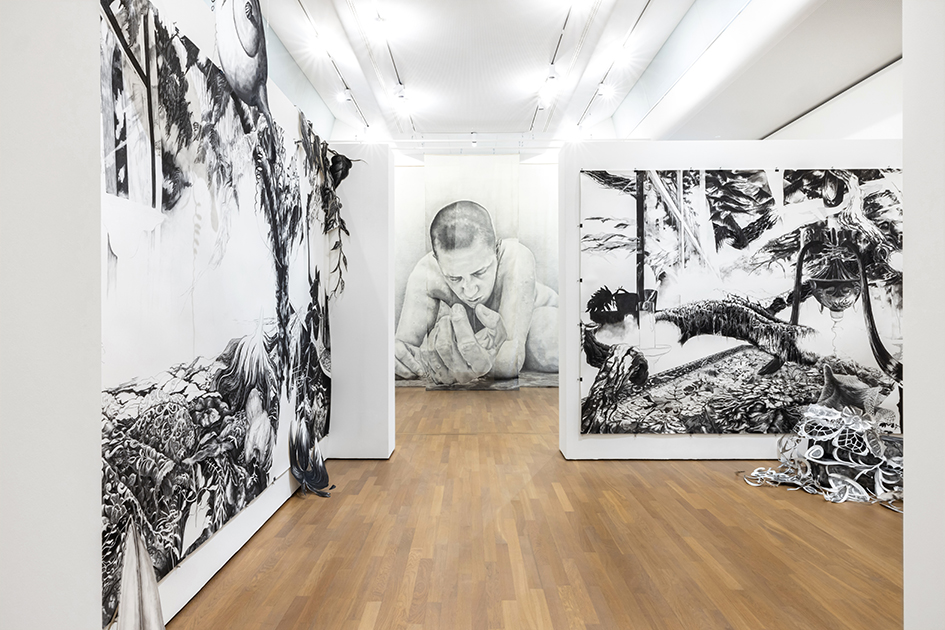
Overview of the exhibition Size Matters in Museum MORE, 2024, with work by Agatha van Amée in the background © Eva Broekema
The year has just begun. What’s on the agenda for 2025?
My work is currently on display at the museum exhibition 'Size Matters | Monumental Drawing Art Now'. This exhibition can be seen until 2 February at Museum MORE in Gorssel. I’m also looking ahead to other projects that are still in their early stages.
In addition, I’m collaborating with Linda Seine of Studio Seine on a long-term plan to explore participation in national and international art fairs. Where does my monumental installation and drawing art best fit without site-specific limitations? That’s something I want to investigate further.
What are you working on right now?
I’m conducting research within my practice, further exploring how my background and place of birth resonate in my work. The research is still in the experimental phase, which means I’m reading a lot, exploring materials and doing small studies. I hope to present the first results at the end of the year in my gallery, Studio Seine in Rotterdam.
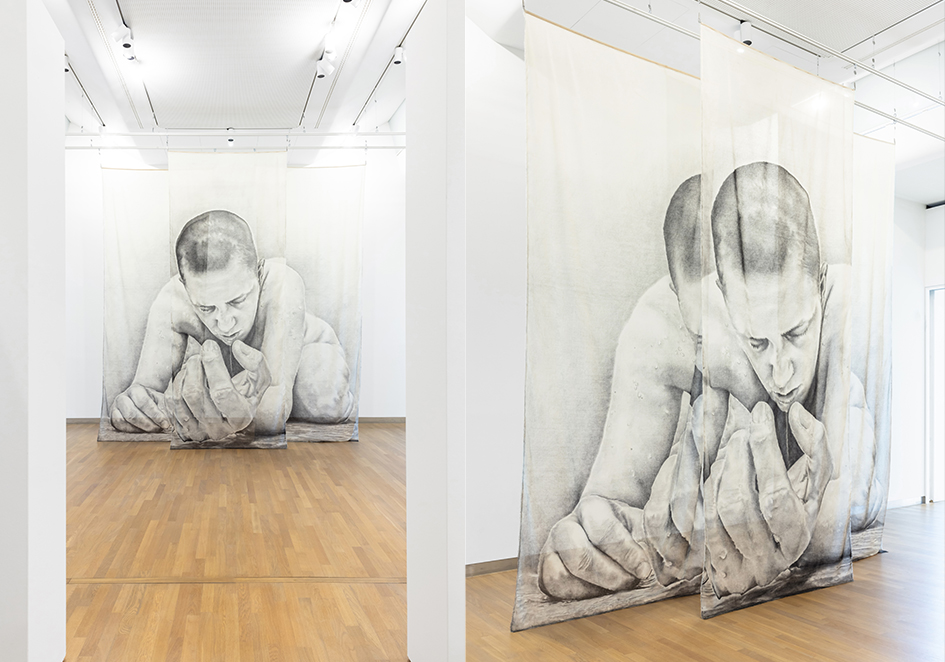
Lise Sore, Worn self-portrait, 2024. Mixed chalk on unbleached cotton. Installation 5* 160 x 420 cm © Eva Broekema
